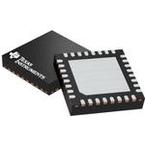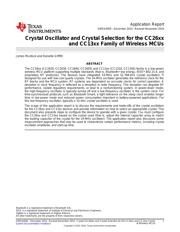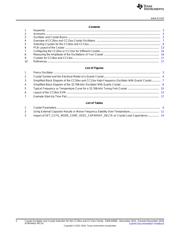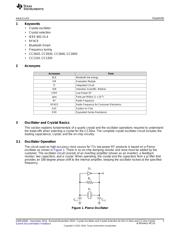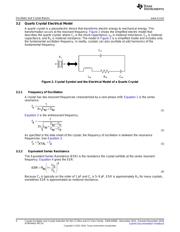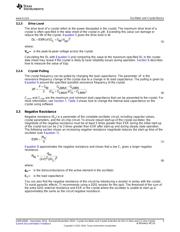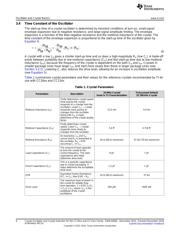herunterladen

1
SWRA495E–December 2015–Revised November 2016
Submit Documentation Feedback
Copyright © 2015–2016, Texas Instruments Incorporated
Crystal Oscillator and Crystal Selection for the CC26xx and CC13xx Family
of Wireless MCUs
Bluetooth is a registered trademark of Bluetooth SIG.
IEEE is a registered trademark of Institute of Electrical and Electronics Engineers.
ZigBee is a registered trademark of ZigBee Alliance.
All other trademarks are the property of their respective owners.
Application Report
SWRA495E–December 2015–Revised November 2016
Crystal Oscillator and Crystal Selection for the CC26xx
and CC13xx Family of Wireless MCUs
James Murdock and Danielle Griffith
ABSTRACT
The CC26xx (CC2620, CC2630, CC2640, CC2650) and CC13xx (CC1310, CC1350) family is a low-power
wireless MCU platform supporting multiple standards (that is, Bluetooth
®
low energy, IEEE
®
802.15.4, and
proprietary RF protocols). The devices have integrated 24-MHz and 32.768-kHz crystal oscillators TI
designed for use with low-cost quartz crystals. The 24-MHz oscillator generates the reference clock for the
RF blocks and the MCU system. RF systems are dependent on accurate clocks for correct operation. A
deviation in clock frequency is reflected as a deviation in radio frequency. This deviation can degrade RF
performance, violate regulatory requirements, or lead to a nonfunctioning system. In power-down mode,
the high-frequency oscillator is typically turned off and a low-frequency oscillator is the system clock. For
time-synchronized protocols such as Bluetooth Smart, a tight tolerance on the sleep clock enables longer
time in low-power mode and reduced power consumption important in battery-powered applications. For
this low-frequency oscillator, typically a 32-kHz crystal oscillator is used.
The scope of this application report is to discuss the requirements and trade-offs of the crystal oscillators
for the CC26xx and CC13xx devices and provide information on how to select an appropriate crystal. This
document also presents steps to configure the device to operate with a given crystal. You must configure
the CC26xx and CC13xx based on the crystal used (that is, adjust the internal capacitor array to match
the loading capacitor of the crystal for the 24-MHz oscillator). The application report also discusses some
measurement approaches that may be used to characterize certain performance metrics, including crystal
oscillator amplitude, and start-up time.
Verzeichnis
- ・ Blockdiagramm on Seite 7 Seite 8
- ・ Technische Daten on Seite 17
- ・ Anwendungsbereich on Seite 19

